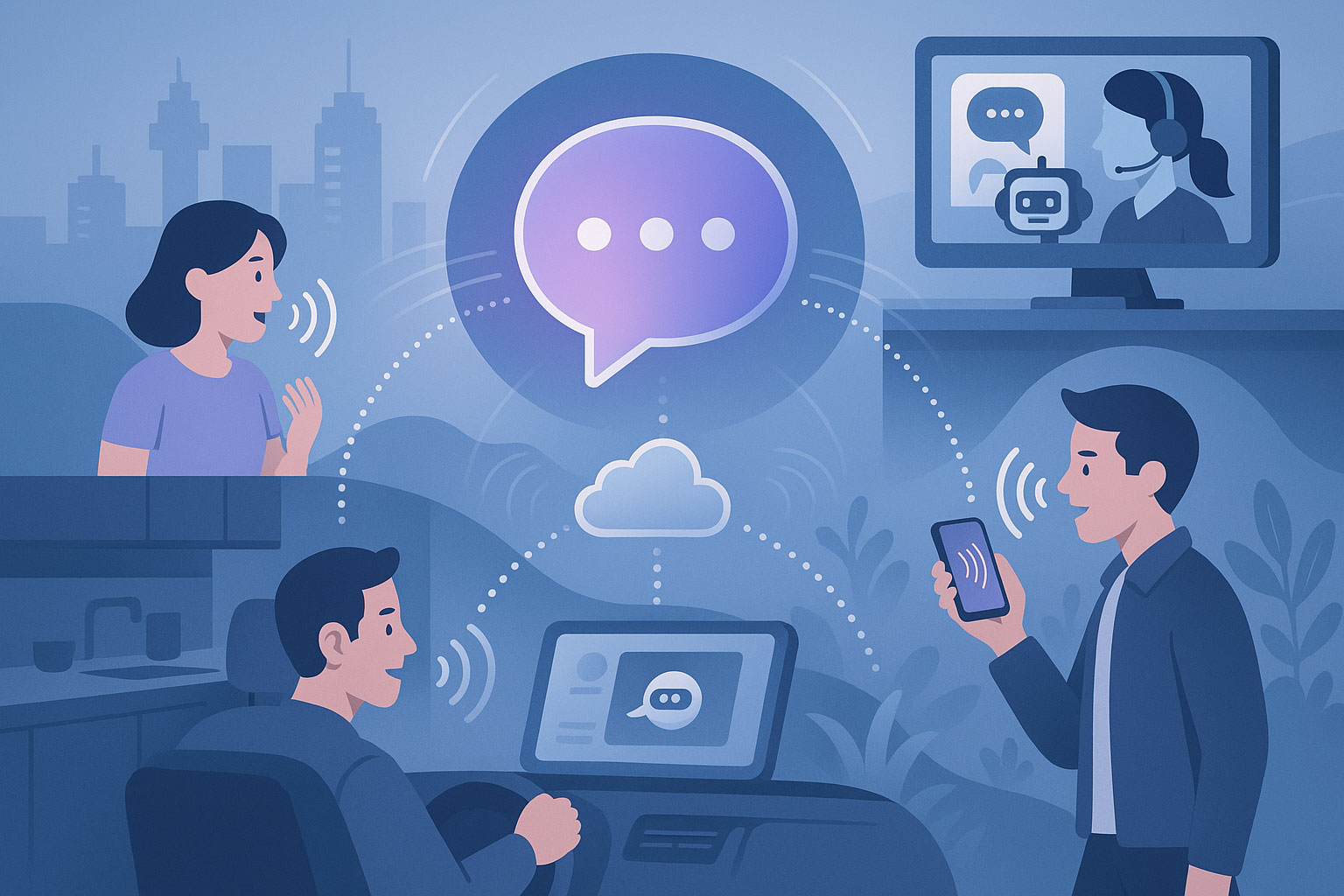
Adapting Chatbots for Voice Search and Shifts in Customer Behaviour
Australians are increasingly speaking rather than typing when they search for information or contact a business. From home devices like smart speakers to mobile assistants and in-car systems, voice search is now a normal part of daily life. Customers ask complete questions aloud, expecting an instant, conversational reply.
For businesses, this shift changes how digital communication must work. Traditional chatbots were built around text commands and menu selections. In contrast, voice interactions are fluid, natural, and often unstructured. Chatbots must now listen, interpret, and respond with human-like understanding.
With the growing use of AI-powered chatbots, companies are discovering how voice-driven interactions can improve accessibility, speed, and customer satisfaction. The challenge is designing systems that respond accurately to real speech while preserving the warmth of human communication.
How Voice Search is Changing Customer Behaviour
Voice search has redefined customer expectations. People no longer think in keywords; they express themselves in full sentences. When someone says, “What time does my delivery arrive?” they expect the system to recognise intent, identify their account, and provide a personalised answer.
Customers also value convenience. Speaking is faster than typing, and it feels more natural when they are multitasking or on the move. This hands-free communication style has become popular among commuters, parents, and field workers who need information quickly.
Generational differences play a role too. Younger users, raised on voice assistants, treat spoken search as normal, while older users appreciate the accessibility benefits it brings. For those with visual impairments or physical limitations, voice interfaces make services far easier to access. The pattern is clear: customers want service that fits seamlessly into their routines, not systems that force them to adapt.
The Technical Difference Between Text and Voice Interactions
Responding to a typed question is simple compared to understanding a spoken one. Voice input carries accent variation, hesitation, background noise, and informal phrasing. A person might say, “Hey, I think the power’s out again over in Parramatta,” rather than, “Report power outage Parramatta.”
To process such input, chatbots rely on speech recognition and Natural Language Processing (NLP) to convert spoken words into meaning. NLP identifies the intent of what the user wants, while Natural Language Understanding (NLU) handles context and phrasing. Machine learning models improve accuracy over time as they analyse more conversations.
The result is a chatbot that no longer just reacts to keywords but interprets complete thoughts. For businesses, this evolution means their systems must be trained on real voice data, not just written scripts. The better the model understands human speech patterns, the more useful and reliable the chatbot becomes.
Designing Chatbots That Understand Natural Conversation
Voice-ready chatbots must be designed for conversation, not command lines. Instead of expecting perfect phrasing, they need to recognise intent even when users wander off topic or use slang.
Good design starts with short, simple prompts that guide the exchange without interrupting flow. When uncertainty arises, the chatbot should confirm details politely, for example, “Did you mean your most recent order?” rather than replying with a generic error. This approach mirrors how people communicate in real life.
Contextual memory is another essential feature. A well-built chatbot remembers previous steps in the conversation, allowing for follow-up questions like “And can you send that receipt to my email?” without re-entering information. The experience feels smoother and more intelligent while remaining transparent about automation.
The goal is not to imitate humans perfectly but to respond with natural rhythm and helpful precision. A conversational chatbot makes users feel understood rather than processed.
The Role of Voice-Enabled Chatbots in Customer Service
Customer service is where voice-enabled chatbots have the most visible impact. They allow organisations to offer instant, round-the-clock support without overwhelming their teams.
After hours, these systems can greet callers, identify account details, and provide real-time information such as order updates, outage alerts, or payment confirmations. When issues require escalation, they forward the call or message to the right department automatically.
During high-volume periods, voice chatbots reduce waiting times by handling routine tasks, freeing human agents to focus on complex cases. In sectors such as healthcare, utilities, and retail, this balance between automation and empathy ensures customers are heard quickly without compromising quality.
Customers appreciate being able to speak normally, and businesses gain reliability, consistency, and data for performance review. It’s a practical example of how technology can strengthen service rather than replace the people behind it.
Benefits for Businesses Adopting Voice-Ready Chatbots
The business case for voice chatbots is straightforward. They improve accessibility, reduce friction, and generate insights into customer intent. Every conversation reveals how people describe their problems in their own words, giving companies better data for product and service improvement.
Voice chatbots also enhance operational efficiency. A single automated system can manage hundreds of interactions simultaneously, capturing details accurately and forwarding them to internal systems. For small and medium enterprises, this removes the need for large support teams while maintaining professional responsiveness.
Perhaps most importantly, voice capability signals modernity. Customers interpret smooth, conversational service as a sign that the brand is forward-thinking and adaptable. That perception can influence loyalty as much as pricing or product quality.
Implementation Challenges and How to Overcome Them
Deploying a voice-enabled chatbot is not without challenges. Australia’s wide range of accents and regional speech patterns requires extensive language training to ensure recognition accuracy. Informal or emotional speech can still confuse AI systems, leading to misinterpretation or frustration.
Another issue is integration. Many organisations already operate text-based chatbots or IVR systems, and adding voice functionality means connecting these tools through secure APIs. Privacy is also critical. Voice interactions generate recordings that qualify as personal information, requiring compliance with the Privacy Act 1988 (Cth) and related data protection laws.
To overcome these challenges, businesses should conduct regular real-world testing, collect feedback from diverse users. Continuous model updates are essential to capture emerging slang and phrasing. Most importantly, partnering with an experienced chatbot provider familiar with Australian communication standards can help balance efficiency with compliance.
The Future of Voice Search and Chatbot Integration
Voice technology is moving beyond basic queries. Future chatbots will detect tone, emotion, and urgency, adapting responses accordingly. A frustrated caller will receive empathetic prompts, while a routine request will be resolved quickly with minimal dialogue.
The boundary between channels is also fading. Customers might start a query via voice, receive follow-up information by text, and confirm completion by email, all through a unified system. Chatbots will act as the central hub linking these touchpoints, creating a continuous experience rather than isolated interactions.
Businesses that prepare for this integration now will gain an advantage as expectations continue to rise. Investing in conversational design and responsible AI development will position them to serve customers with greater accuracy and empathy. The ability to listen, understand, and respond naturally is becoming a defining feature of modern service excellence.
FAQ’s
Q1: How is voice search influencing chatbot design?
A1: Voice search encourages chatbots to recognise natural speech, interpret intent, and deliver responses in conversational language, improving accessibility and engagement.
Q2: What industries benefit most from voice-enabled chatbots?
A2: Retail, utilities, healthcare, and finance use voice chatbots to handle large call volumes, provide real-time information, and reduce customer wait times.
Q3: Can existing text chatbots be upgraded for voice?
A3: Yes. Most platforms can add speech recognition and audio output through API integration, allowing text-based systems to support spoken interaction.
Q4: Are voice chatbots suitable for after-hours customer service?
A4: They are ideal for it. Voice chatbots can answer routine queries, report issues, and escalate emergencies when staff are offline, ensuring 24-hour responsiveness.
Q5: How do businesses ensure privacy with voice chatbots?
A5: Recordings must be stored securely, access must be limited, and users should be informed that interactions may be recorded in accordance with Australian privacy laws.



